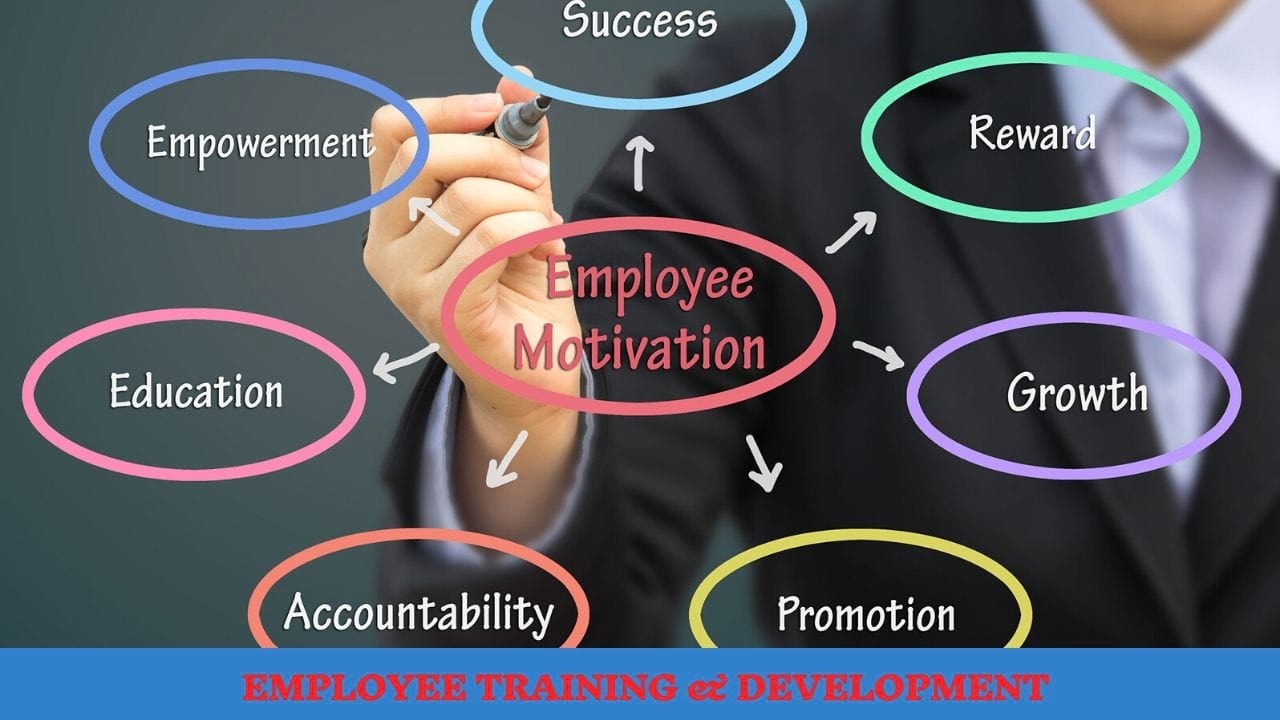Image : (https://www.sandler.com/blog/why-are-training-and-development-important/)
Human
resource (HR) is the most critical factor that decide the prospectus of an
organization. Workers are the most important resource of each organization as
they can represent the deciding moment of an organization's notoriety and can unfavourably
impact benefit. Today Human Resource Management (HRM) requires being strategic
partner in the organization by aligning the HR role with their vision, mission,
& strategic goals of organization. HRM expects to add value by utilizing of
employees & employee programs by improving abilities, knowledge and skills
of the gifted workforce be a major source of competitive advantage in a global
market
Image : (https://www.toppr.com/guides/business-management-and-entrepreneurship/human-resource- management/training-and-development/)
Concept of Training
Training is
usually key requirement which takes place to contribute for enhancing
effectiveness and efficiency of an organization. “Training is a process whereby
people acquire capabilities to aid in the achievement of organizational goals”
Training is
arranged intercession with the goal of expanding segments of individual job
performance
Importance of Training and Development
Image : (benefits-of-training-and-development.jpg (1280×720) (hrmfunction.com))
Training is a
weapon of today organizations to pick up the upper hands. Organizations can
accomplish a several benefits including worker commitment, collective
empowerment and high job satisfaction
With the help of
training, employees can increase their competency level both quality &
quantity of performance of a job. Innovations is the style of progression in
today business organizations. Through training employees can be obtained new
skills, process required theoretical knowledge & creative thinking of their
operations. Moreover, training help to create better safety working
environments & help maintain zero accidents. According to Anonymous (1998),
Training is basic to build productivity and motivation level of employees by
clarifying them valuation of their job role and encourage them giving
fundamental details to perform job.
According to
Cole (2001), employees can obtain High morale, better economic scale by
producing lower cost of production, enhance sense of security at the workplace
through lower turnover and absenteeism, willingness to accept organizational
changes, enhanced employee responsibility and higher payments & promotions
opportunities as benefits of training.
Employees are
more worried about their occupational performance, then they looking chances to
build their profession through preparing with high employment involvement.
Because of above; organization can maintain lower labour turnover. In addition,
if employee is given poor training, their morale will be decrease. Greater
attitudes of employee on training can build a great collaboration &
organizational loyalty.
Conclusion
There are many
ways of overcoming deficiencies in employee performance at work, and training
is one of them. The finding of the study shall be crucial both practical &
theoretical way. Therefore, the company reserves more monetary sum for training
programs from their financial plan to accomplish the higher employee
performance.
References
DS Chiaburu, AG Tekleab, 2005. Individual and contextual influences on
multiple dimensions of training effectiveness.
Mathis and Jackson, 2000. Impact of Training and Development Programs on
Employee Performance.
McKinsey, Quarterly (2006). An executive take on the top business
trends. a McKinsey Global Survey.
Robert L. Cross, R. D. M. a., 2006, August 1. Mapping the value of
employee collaboration. As collaboration within and among organizations
becomes increasingly important, companies must improve their management of
the networks where it typically occurs.
Rowden, R. W., 02 December 2002. The relationship between workplace
learning and job satisfaction in U.S. small to midsize businesses.
Somasundaram, U. V., 2004. Training and Development: An Examination of
Definitions and Dependent Variables.




Training and development is playing a significant part in human resource management. Which will increase employee engagement, increase productivity level, reduce labour turn over and retain the skilled employees with the organization, Enhance job satisfaction. However it comes with drawbacks for instant High cost of implementing training and development, High time consumption and Difficult to measure the improvement.
ReplyDeleteThank you for your valuable comment. To address your concern, yes its true it is some times high cost involved and time consuming. But I would sugeest you to rather see that as a long term investment instead of seeing as a drawback which will benefit to the organization throughout. Of course a company should engage in a proper evaluation method to avoid difficulties in measuring employee performance. I would further suggest you to go through my next article published on "Beyond the Basic - Processes and Strategies in Employee T&D" where i have discussed the process of training and factors affecting on effectiveness of employee training. If a company would follow these processes and steps trust it would be able to mitigate these drawbacks to a greater extent.
DeleteTraining plays a vital part in employee performance. It enhances employee skills and competencies while boosting employee morale and engagement. As a result, it improves the productivity of the organisations and produce better financial results. Most important, cost element also would take a role during training.
ReplyDeleteAppreciate your valuable feedback Kabilashini. As I have suggested in above reply to Azeem, I am in the view of that rather to consider the cost element it is important to see that as long term investment from the company's perspective benefiting over the years.
DeleteOverall, your article serves as a reminder of the critical role HRM and training play in the success of an organization. It is important for organizations to prioritize training and development as it can help improve the job satisfaction, performance, and loyalty of their employees.
ReplyDeleteThank you for your comment Hansika. Very true.
DeleteThis comment has been removed by the author.
ReplyDeleteWell-defined article on the T&D concept. Torraco, R. (2016) mentioned, T&D concept lead and followed its engagement in World War II, The booming wartime economy and technological advancements during this time period led to a sharp rise in the demand for qualified labor. Employee training and development increased during this time as a result of the growth of the American labor movement. The American labor movement now strongly supports training after overcoming significant opposition to its foundation in the early 1900s.
ReplyDeleteThank you Janka for your feedback on the article. I appreciate your insights on the historical context of training and development (T&D) and the impact of World War II on its evolution. Torraco (2016) indeed mentions how the T&D concept gained momentum during World War II due to the booming economy and technological advancements, which led to an increased demand for skilled labor. The labor movement in America also played a significant role in supporting training and development initiatives, despite facing opposition in its early stages in the 1900s.
DeleteIt is interesting to note how the historical context shaped the trajectory of T&D and its significance in addressing the evolving needs of the workforce. The wartime economy and labor movement were key drivers that contributed to the growth of T&D during that period. Today, T&D continues to play a crucial role in organizations, helping them adapt to changing business landscapes and equipping employees with the necessary knowledge and skills to excel in their roles.
Once again, thank you for your valuable input, and I'm glad you found the article well-defined. If you have any further insights or comments, I would be happy to discuss them further.
Excellent post on the significance of employee growth and training! HRM should be a strategic partner in an organisation, and investing in personnel via training and development is a significant source of competitive advantage.
ReplyDeleteI appreciated how the author framed training as a process of learning capabilities to help organisations achieve their goals. This is critical since training should always be tied to the organization's strategic goals.
Thank you for your comment! I completely agree with you that investing in employee training and development is a significant source of competitive advantage. As you noted, HRM plays a critical role in ensuring that training initiatives are aligned with the organization's strategic goals. By doing so, organizations can improve employee performance and achieve their objectives more efficiently. It's essential to view training as a continuous process of learning and development rather than a one-time event to ensure that employees are equipped with the necessary skills and knowledge to adapt to changing business environments.
Delete